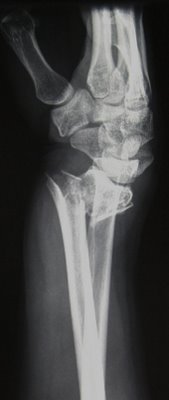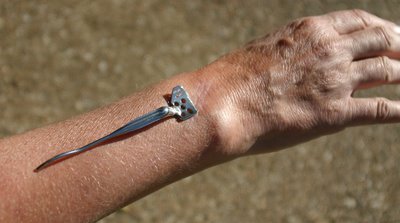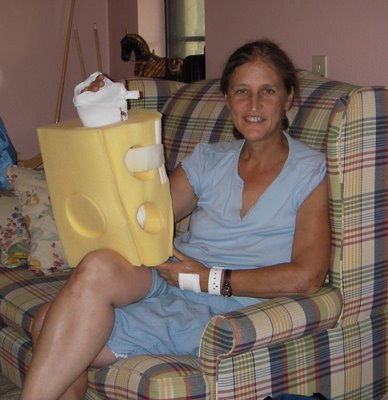When I broke my wrist last year I thought I had a standard condition. Haven’t doctors been fixing broken bones since Hippocrates? If they can’t get that right, how can they possibly do complicated procedures like organ transplants? I was in for a rude awakening.
I suppose every break is a little different and mine was particularly bad. I broke off the distal end of my radius and shoved the broken shaft of bone into my wrist. My hand twisted and the palm collapsed in on itself. Still, I’d heard of worse. I was in shock when I got to the ER but that doesn’t explain my confidence in the medical profession. Brain washing by such TV shows as ER and Marcus Welby explained that.
It took several months before I realized things weren’t going well. How long does a broken wrist take to heal anyway? My physical therapist recommended a medieval-looking device called a supination split. I was to wear it while sleeping. How could anyone sleep with that contraption of metal, and Velcro wrapped around their arm? You have to be very tired.
Four months of the split convinced my doctor that it wasn’t working. Time to try something new. How about a surgical procedure called a Suave-Kapandji (SK)? How about cutting my ulna in two, pinning the wrist end to my radius and letting the section attached to my elbow just ‘flap in the wind’? “It takes some getting used to,” my doctor said. I was worried. Is it okay for a bone not to be connected to anything on one end? You don’t really need it, the doctor explained, it’s extra like your appendix. Call me skeptical, I decided to get a second opinion.
I went to a doctor recommended by my doctor. You wouldn’t go to your mechanics best friend for unbiased advice would you? I assumed doctors were above that kind of thing. Even so, Dr. #2 did not completely agree with Dr. #1. Could do an SK, he said, or could just cut a section out of the ulna and pin it back together, a procedure called an ulnar shortening.
I needed another opinion, someone who would agree with one of the previous doctors. But Dr. #3 came up with a completely new procedure--radial reconstruction. He would take out the pin Dr. #1 put in, cut the radius apart and restore it to its original length using a bone graft from my hip. I was stunned. How did my hip get involved? Time for another opinion.
Dr. #4 took a cat scan of my wrist. He examined it closely and proclaimed there was nothing wrong that a good shot of cortisone wouldn’t fix. Dr. #1 had already given me cortisone but Dr. #4 said he didn’t do it right. He must not have done it right either because it didn’t work again.
There was only minimal agreement in the diagnosis I’d gotten. Drs #3 and #4 were both adamantly against an SK. Both said an ulna shortening was possible but probably wouldn’t help. Since I didn’t want to spend the rest of my life getting more opinions, I decided to go with Dr. #3. His procedure could be done in two parts, first remove the pin then reconstruct the radius. Removing the pin sounded reasonable.
Dr. #3 examined the cat scan taken by Dr. #4. Diagnostic tests are nice, he said, but have no correlation to symptoms. People with good diagnostics can have debilitating symptoms while people with no symptoms might have terrible diagnostics. Then why do they call them “diagnostics?” They don’t diagnose anything.
During surgery, Dr. #3 noted extensive scaring involving the pin and the tendons and other tissues surrounding it. A week later I was able to rotate my arm freely. Two weeks after that, I got full range of motion back in my thumb. Within two months all of my major complaints were resolved. My doctor expressed surprise but gave me a clean bill of health and discharged me from his care.
Turns out I didn't need a radial reconstruction or ulnar shortening or the horrendous Suave-Kapandji. But I might have had any one of those. In science there's usually a right answer. In medicine you just have to cross your fingers--if you can.
X-Ray of my wrist right after the break. X-ray of my wrist with the pin installed.
X-ray of my wrist with the pin installed. My pin lying on top of the wrist it once held together. I'm thinking of making it into a bracelet.
My pin lying on top of the wrist it once held together. I'm thinking of making it into a bracelet.  Me the day I broke my wrist. That "cheese" really helped support my arm so I could sleep.
Me the day I broke my wrist. That "cheese" really helped support my arm so I could sleep.

7 comments:
I am having a hard time deciding to have this procedure or not. I'm worried about strength and stability after surgery. I'm a worker bee and concerned about my abilities after. Will you email with me to discuss how it has effected your life? thx for your time. James Weaver weav199@yahoo.com
At least you don't work with doctors every day and still expect them to do the right thing! I know better- that doctors don't always make the right decisions, but I still trusted them to fix my broken wrist without surgery. So they put me in a cast and three months later my radius came out much shorter than it started. So my only options were to have the ulnar shortening, so now I have two weak bones and daily, constant pain because the plate was put in incorrectly. I commend you for getting multiple opinions and wish I had done the same. Never assume that the doctor knows best. They may be genuine, but just not know...
You are a compulsive consumer of health care dollars. Four opinions? Sheesh, it was just your wrist...
Okay, I have to respond to the anonymous post. "Compulsive consumer of health care dollars" and "Just your wrist"? Think for a moment about what you are saying. First of all, this is the wrist that she (or I, or anyone) will be stuck with for the rest of her life. Second of all, walk through your day, the whole day, and notice how many things you use your wrist for. Let me tell you some of the things that I couldn't and can't do until mine gets fixed. I can't open a door knob with one hand, can't open the trunk of my car, can't scratch my ear, can't pick the lid up off the pot on the stove, can't hold my plate in my left hand while eating with the right, can't carry two plates to the table, can't lift ANYTHING over about 2 pounds with my left hand, can't take change, can't put anything in my left hand that requires palm up (money, medicine, paperclips, WHATEVER), can't carry a child, can't pick a child up, can't crochet, can't ski.....Get the picture? Try going through your day and take your dominant hand and don't rotate it from neutral (the hand-shake position) all day. There are THOUSANDS of things you can no longer do. So I have to disagree with the "just your wrist" statement. It isn't just your wrist, it is your life and the quality of life you are used to. It is also the bones you are stuck with for maybe another fifty years. So good for her for getting four opinions, and thank goodness she didn't get the procedure that she didn't need and could have ruined her quality of life even more! Sorry to be so passionate about it, but you can't know how your life is impacted until you lose something so fundamental as mobility.
As for the comment: "its just your wrist"
Try getting dressed with one hand, ever tie your shoe with one hand?
Try going through your day, with the use of one hand, then see if you have the same comment.
I injured my left hand with 4 torn ligaments. I have now had a pin in my hand-worked its way out, an ulnar shortening, fusion of two bones in the hand, ulnar tunnel release, and my last (hopefully) surgery involved a ulnar bone/wrist bone fusion and a Suave-Kapandji-eek
Just had the kapendji procedure two days ago, in an immense amount of pain, too soon to tell if procedure will work, already tried ulna shortening. Looking for foam, looks like it would provide some much needed relief,great idea.
k3d64p9q87 v8e36s2o24 m9g53g7z89 f8v71s0q59 h0e86z6h89 l5q03e2i37
Post a Comment